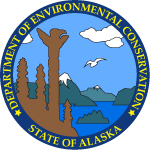| Action Date |
Action |
Description |
DEC Staff |
| 11/18/2008 |
Site Added to Database |
A new site has been added to the database |
Mitzi Read |
| 11/20/2008 |
Potentially Responsible Party/State Interest Letter |
DEC staff issued a letter, dated November 20th, to Wilder Construction Company to inform
them of their responsible party status for contamination at the Palmer Central Paving Product Gravel Pit. Additionally, DEC approved of Terrasat’s October 20, 2008 work plan, which was received at DEC's Anchorage Office on October 24th. Terrasat noted in its work plan that they have previously identified 158 stained areas at the subject site. 113 of the stained areas are less than 16 square feet, 38 areas ranged from 16 to 256 square feet, and seven stains are greater than 256 square feet. Terrasat proposed to remove discolored soil from the small stains (i.e. less than 16 square feet), place this soil on a Permalon liner and then grade the area with a road grader, bulldozer, or snowplow. Soil left in place from these areas would be cleaned up to visual, olfactory or PID headspace examination. The discolored soil from the 38 stained areas (i.e. 16 to 256 square feet) will be excavated stockpiled during the winter months. Terrasat would collect one confirmation sample from each of these areas. The soil will then be composited from two other areas prior to analysis. Seven soil stains that exceed 256 square feet in size will be excavated and stockpiled. One confirmation sample per 256 square feet will be collected to confirm all contaminated soil was removed. If contaminated soil is greater than 3 feet in depth a groundwater monitor well will be installed to evaluate the levels of dissolved contaminants of concern.
|
Todd Blessing |
| 10/20/2009 |
Site Characterization Workplan Approved |
DEC staff reviewed and conditionally approved SLR’s “Granite Palmer Facility 2009 Additional Investigation Work Plan”, Dated October 2009. Within the work plan, SLR proposed to do the following:
1. Continue excavation of petroleum impacted soil and place this soil on a lined containment area;
2. Field screen potentially contaminated soil using a combination of screening methods (i.e. PID and PetroFlag turbidimetric). Field screening samples will be collected at a ratio of one square foot for every 100 square feet of excavation pit base and 1 linear foot for every 10 linear feet of the excavation sidewall;
3. Collect confirmation samples based on field screening results to be analyzed for GRO, DRO, RRO, and BTEX;
4. Install a maximum of four groundwater monitoring wells using pre-pack wells installed into test pits. One to two of the wells will be installed in areas suspected to be most contaminated and the remaining wells will be located between excavation areas and the nearest downgradient receptor. Groundwater samples will be analyzed for GRO, DRO, RRO, BTEX, and polynuclear aromatic hydrocarbons.
|
Todd Blessing |
| 9/2/2010 |
Site Characterization Report Approved |
DEC staff reviewed SLR’s “Granite Palmer Facility 2009 Additional Investigation Report Palmer, Alaska”, Dated July 2010. In this report, SLR documented the excavation of contaminated soil from the following areas: PP113, PP120, PP147, and PP154. Granite construction estimated that a total volume of 684 cubic yards of contaminated soil was excavated from these areas and placed in a lined, covered, and bermed containment area at the Palmer site. Thirty four confirmation soil samples were collected from the four excavation areas and no contaminants of concern were detected above DEC cleanup levels. In a letter dated September 2, 2010, DEC requested that Granite Construction facilitate the the installation of four groundwater monitoring wells as discussed in SLR’s October 2009 work plan that was approved by DEC on October 20, 2009. These groundwater monitoring wells will be sampled after well development and purging for the following parameters: GRO, DRO, RRO, BTEX, and polynuclear aromatic hydrocarbons. DEC also requested that Granite Construction submit a soil treatment plan for DEC review and approval.
|
Todd Blessing |
| 6/2/2011 |
Site Characterization Report Approved |
DEC staff reviewed SLR's "2010 Monitoring Well Installation and Ground Water Sampling Report Granite Construction – Palmer Site”, Dated February 8, 2011. In this report, SLR documented the installation, sampling, and testing of four groundwater monitoring wells installed within the footprint of formerly identified contaminated areas. Groundwater samples were collected from each newly installed well and analyzed for GRO, DRO, RRO, and BTEX. No contaminants of concern were detected in any of the groundwater samples suggesting that groundwater is not currently impacted from prior spills. In this report, SLR recommended that the groundwater monitoring wells be decommissioned and the stockpiled soil be incorporated into asphalt production process. DEC staff issued a letter on June 2, 2010 requesting Granite Construction submit monitoring well decommissioning and soil treatment work plans. |
Todd Blessing |
| 3/29/2012 |
Update or Other Action |
DEC staff requested a work plan from Shawn Crouse for treatment of remaining contaminated soil. |
Todd Blessing |
| 7/2/2015 |
Update or Other Action |
Spoke and exchanged emails with current RP representative. I approved the existing plan to decommission the monitoring wells. I asked for a revised soil disposal plan for the 684 cubic yards of material still stockpiled at the site for disposal. |
Lisa Krebs-Barsis |
| 9/10/2015 |
Document, Report, or Work plan Review - other |
Reviewed and approved the report of the July 6, 2015 decommissioning of the monitoring wells. |
Lisa Krebs-Barsis |
| 10/13/2015 |
Meeting or Teleconference Held |
Met with RP's representative to discuss updated soil disposal plan. |
Lisa Krebs-Barsis |
| 10/13/2015 |
Document, Report, or Work plan Review - other |
Approved of updated soil disposal plan to use the 684 cubic yards for asphalt paving at site. |
Lisa Krebs-Barsis |
| 11/3/2015 |
Document, Report, or Work plan Review - other |
Reviewed final report describing the use of the contaminated soil in asphalt paving at a location on site that will be used as an equipment/material laydown area. |
Lisa Krebs-Barsis |
| 2/1/2016 |
Cleanup Complete Determination Issued |
Based on the information available, ADEC has determined no further assessment or cleanup action is required. There is no longer a risk to human health or the environment, and this site will be designated as closed on the Department's database. It should be noted that movement or use of potentially contaminated soil in a manner that results in a violation of 18 AAC 70 water quality standards is unlawful. This determination is in accordance with 18 AAC 75.380(d) and does not preclude ADEC from requiring additional assessment and/or cleanup action if future information indicates that this site may pose an unacceptable risk to human health or the environment. |
Lisa Krebs-Barsis |




